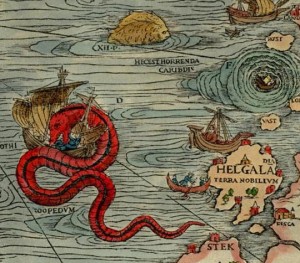The terrifying Great Norway Serpent…
…a legacy of sea monsters.
Olaus Magnus’s Sea Serpent (The Public Domain Review)
The terrifying Great Norway Serpent, or Sea Orm, is the most famous of the many influential sea monsters depicted and described by 16th-century ecclesiastic, cartographer, and historian Olaus Magnus. Joseph Nigg, author of Sea Monsters, explores the iconic and literary legacy of the controversial serpent from its beginnings in the medieval imagination to modern cryptozoology.

The original Sea Orm. Detail from Magnus’s Carta Marina of 1539 showing a bright red monster encircling a ship off the coast of Norway with maelstrom whirling away to the right.
“In his comprehensive study, The Great Sea-Serpent: An Historical and Critical Treatise (1892), Dutch zoologist Antoon Cornelius Oudemans lists more than three hundred references to the notorious sea monster in his chronological “Literature on the Subject.” The first ten of those, 1555-1665, cites Olaus Magnus’s sea serpent: editions of Olaus’s Historia de gentibus septentrionalibus (“History of the Northern Peoples”) and natural histories of Conrad Gesner, Ulisse Aldrovandi, Edward Topsell, and John Jonston. The list establishes Olaus’s serpentine monster as the major ancestral source of sea serpent lore from the sixteenth century to widespread sightings of such creatures in Oudemans’s own time. It is the basis for illustration and discussion of the creature in marine studies and popular fantasy up to the present, five hundred years after Olaus created it…
Read more here.
Share
